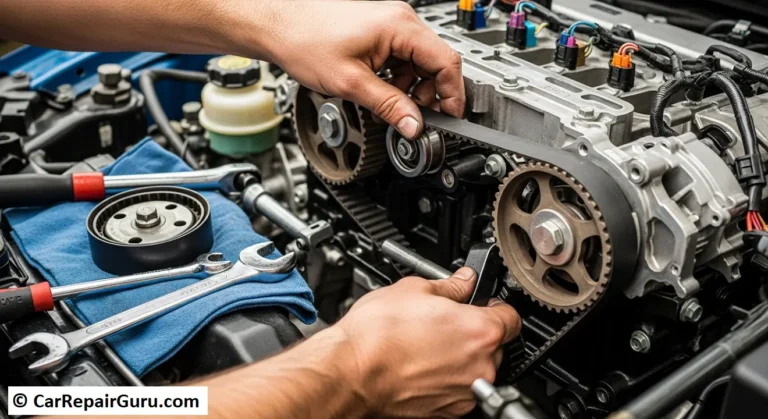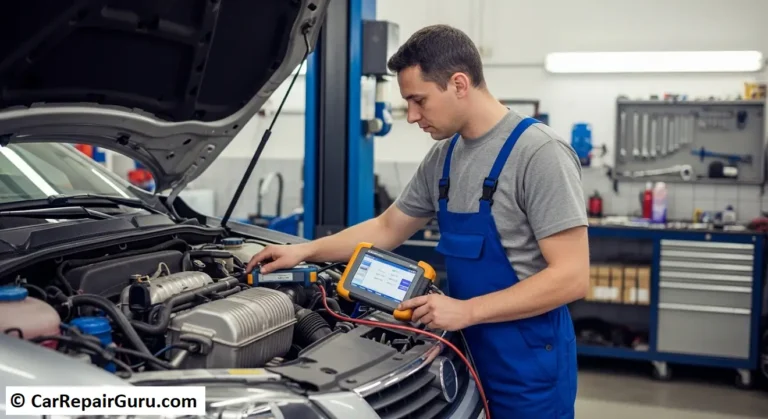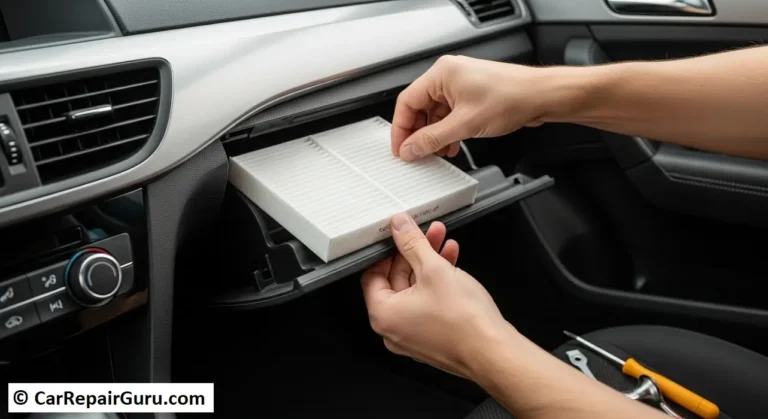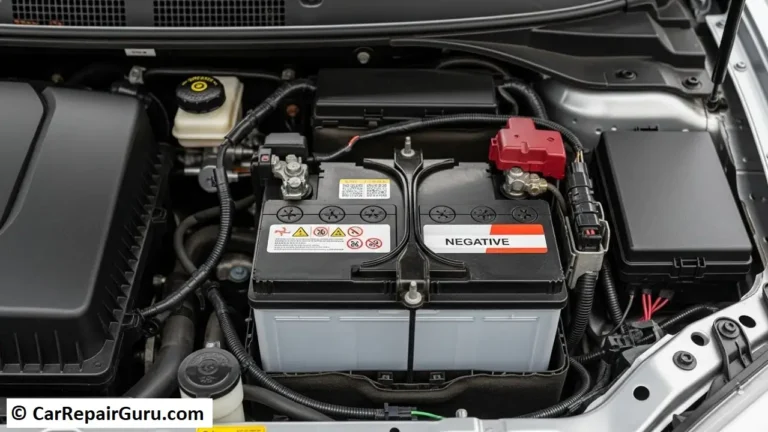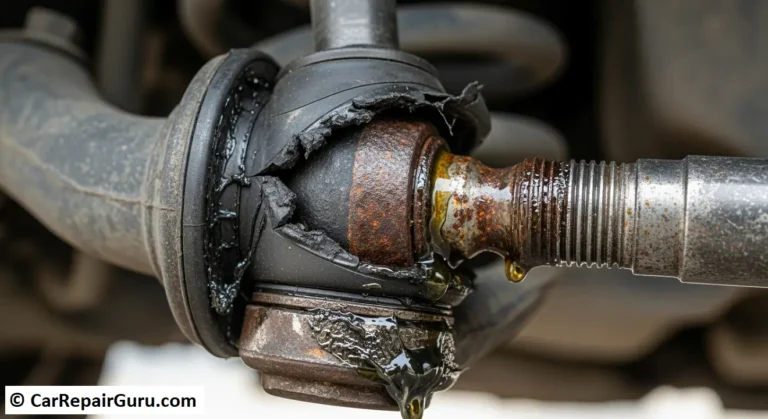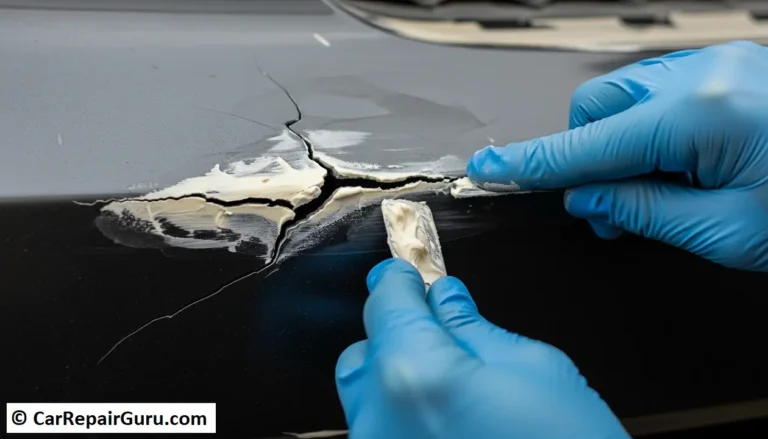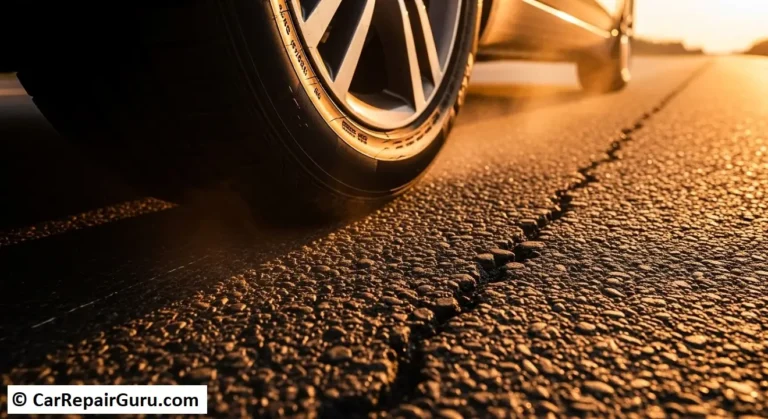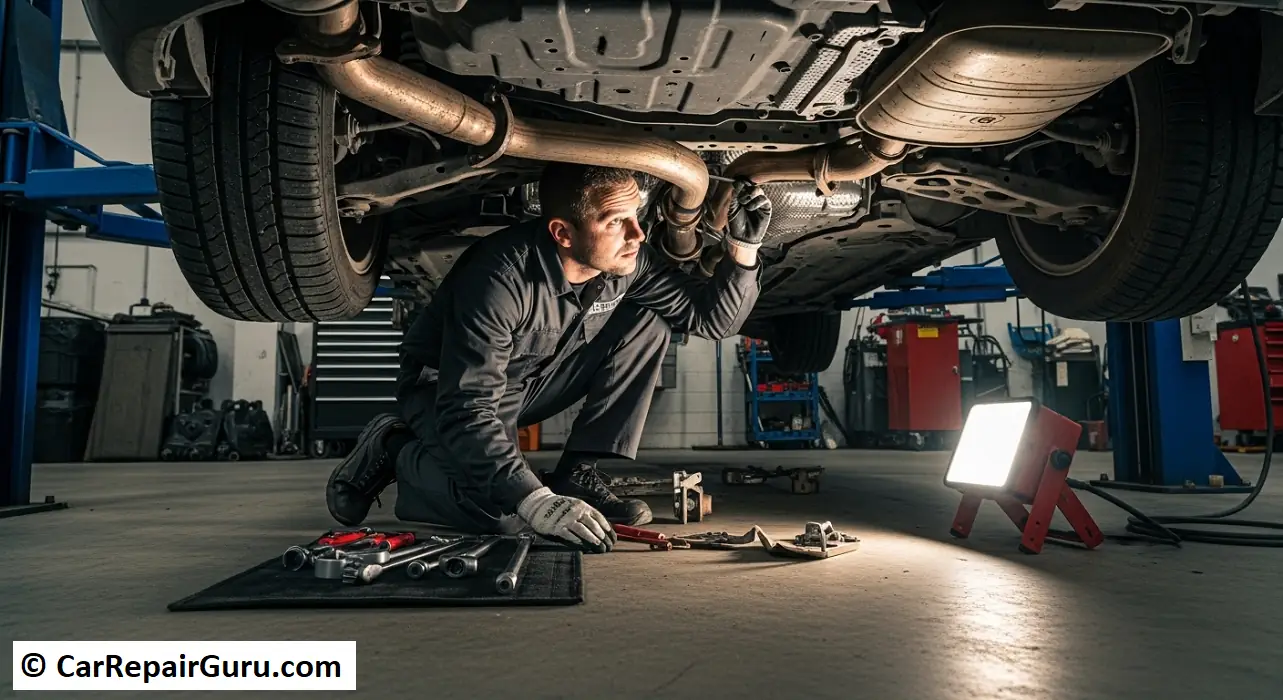
Ever been driving when your quiet car suddenly starts to roar like a racecar? Or maybe you’ve caught a strange whiff of fumes at a stoplight that definitely wasn’t there before. These are classic tell-tale signs that your car’s exhaust system is crying out for attention.
Many drivers think of the exhaust as just a noisy pipe at the back of the car, but it’s a complex and vital system. Proper exhaust system maintenance isn’t just about noise control; it’s a critical part of your car’s safety, efficiency, and overall health.
This guide will walk you through everything you need to know. We’ll cover the simple checks you can do right in your driveway, the warning signs you can’t afford to ignore, and the easy maintenance steps that can save you a fortune in repairs down the road.
The 5 Critical Reasons for Regular Exhaust System Maintenance
Before we get our hands dirty, let’s talk about why this is so important. Ignoring your exhaust system can lead to serious consequences for you, your car, and your wallet.
1. Your Safety – Preventing Carbon Monoxide Leaks
This is the single most important reason. An exhaust leak, especially near the front of the vehicle, can allow deadly, odorless, and colorless carbon monoxide gas to seep into the passenger cabin. Exposure can cause dizziness, headaches, and in severe cases, can be fatal. This alone makes regular checks non-negotiable.
2. Your Wallet – Improving Fuel Efficiency
Your exhaust system is packed with technology, including oxygen (O2) sensors that constantly monitor your exhaust gases. They tell your car’s computer how to adjust the fuel-to-air ratio for maximum efficiency. A leak can throw off these sensors, causing your car to burn more fuel than necessary. A healthy exhaust literally saves you money at the pump.
3. Your Engine’s Health – Ensuring Peak Performance
Your engine needs to “breathe” out just as efficiently as it breathes in. A clogged or damaged exhaust system creates excessive backpressure, essentially forcing the engine to work harder to push out gases. This can lead to a noticeable loss of power, poor acceleration, and long-term engine strain.
4. The Law – Passing Emissions Tests
In many areas, passing an emissions test is required for vehicle registration. The hero of this process is the catalytic converter, which transforms harmful pollutants into less harmful gases. A faulty system is one of the most common reasons for a failed emissions test.
5. The Environment – Reducing Harmful Pollutants
A properly functioning exhaust system, particularly the catalytic converter, dramatically reduces the amount of nitrogen oxides, hydrocarbons, and carbon monoxide your car releases into the atmosphere. Doing your part for air quality starts with good car care.
Understanding the Key Parts of Your Exhaust System
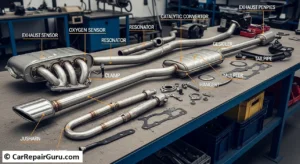
To know what you’re looking for, you first need to know what you’re looking at. While designs vary, most systems contain these core components, starting from the engine and moving to the back of the car.
Exhaust Manifold: This heavy-duty component bolts directly to the engine. Its job is to act as a funnel, collecting the hot exhaust gases from each cylinder and channeling them into a single pipe.
Oxygen (O2) Sensors: These small but brilliant sensors are placed before and after the catalytic converter. They analyze the amount of unburned oxygen in the exhaust to help the engine’s computer fine-tune fuel delivery for optimal performance and low emissions.
Catalytic Converter: This is the emissions-control powerhouse. It looks like a small muffler and contains a ceramic honeycomb coated with precious metals (like platinum and rhodium). As exhaust gases pass through, a chemical reaction converts the most toxic pollutants into water vapor and carbon dioxide.
Resonator & Muffler: These are the noise-canceling headphones of your car. The resonator targets and eliminates specific, unpleasant sound frequencies, while the muffler uses a series of chambers and tubes to reduce the overall volume of the engine’s roar to an acceptable level.
Hangers, Clamps, and Gaskets: These are the unsung heroes. Metal and rubber hangers support the weight of the entire system, clamps secure the pipes together, and gaskets create airtight seals between components. A failure in any of these small parts can cause major problems.
Tailpipe: This is simply the last piece of the puzzle—the visible tip where the exhaust gases finally exit your vehicle.
How to Perform a DIY Car Exhaust Inspection (The 3-Sense Check)
Now for the hands-on part. You don’t need to be a master mechanic to perform a basic car exhaust inspection. All you need are your ears, eyes, and nose.
SAFETY FIRST! Before you even think about looking under your car, follow these rules without exception:
- Park on Solid, Level Ground. Never on grass, dirt, or a slope.
- The Engine Must Be COMPLETELY COOL. The exhaust system gets incredibly hot and can cause severe burns. Wait several hours after driving.
- Wear Safety Glasses and Gloves. Protect yourself from falling rust, dirt, and sharp edges.
- Never Work Under a Car Supported Only By a Jack. If you need to lift the car for a better view, use certified jack stands.
- Never Run the Engine in an Enclosed Space. A garage—even with the door open—can quickly fill with deadly carbon monoxide.
Step 1 – The Sound Check (What to Listen For)
Your ears are your best first-line defense. Listen for these distinct exhaust leak symptoms:
- Loud Roaring or Rumbling: This is the most common sign. A deep, loud noise, especially on acceleration, usually points to a hole in the muffler or a connecting pipe.
- Hissing or Puffing: A subtle hissing or tapping sound, particularly when the engine is cold, can indicate a cracked exhaust manifold or a leaking gasket seal.
- Rattling or Clunking: A metallic rattling noise from underneath the car can have a few causes. It could be a simple loose hanger or heat shield, or it could be one of the more serious catalytic converter problems, where the internal ceramic honeycomb has broken apart.
- Popping/Backfiring: A leak can let oxygen into the hot exhaust stream, causing unburnt fuel to ignite in small, popping explosions.
Step 2 – The Visual Inspection (What to Look For)
With the car cool and safely parked, it’s time to take a look. If your car isn’t too low, you may be able to see most of the system by kneeling.
Hunt for Rust and Corrosion: Rust is the absolute worst enemy of an exhaust system. Look for dark, orange-brown patches that are flaky or blistered. Pay close attention to the seams and welded joints on the muffler and pipes, as this is where rust often starts. If you can poke a hole in it with a screwdriver, it’s time for a repair.
Look for Cracks and Holes: Carefully scan the entire length of the system. Even a small pinhole can grow quickly. If you find a crack or hole, that’s the source of your leak.
Spot the Soot: One of the clearest signs of a bad exhaust system is the presence of black soot. Look for sooty, black stains around the joints, clamps, or any cracks. This is a dead giveaway that exhaust gas is escaping from that spot.
Check the Hangers: Wiggle the exhaust pipe gently (when cool!). It should have a little bit of movement on its rubber hangers but should feel secure. Look for cracked, broken, or missing rubber hangers and ensure the metal hooks are firmly in place. A dangling exhaust is a major road hazard.
Step 3 – The Smell Test (Identifying Unusual Odors)
Don’t ignore what your nose is telling you. Certain smells are a direct link to specific exhaust issues.
- Rotten Eggs (Sulfur): This is the classic symptom of a failing catalytic converter. When it can no longer properly process the sulfur in gasoline, it produces a distinct and unpleasant rotten-egg smell from the tailpipe.
- Gasoline Fumes: If you smell raw gasoline, especially inside the cabin, this is a serious problem. It could indicate a major leak near the engine, which is an immediate fire hazard. Stop driving the car and have it inspected professionally right away.
Simple At-Home Exhaust System Maintenance Tips
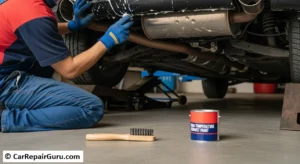
You can significantly extend the life of your exhaust system with a little proactive care.
Wash Your Undercarriage
Especially if you live in an area with snow and salted roads, washing the underside of your car is crucial. Rinsing away road salt, mud, and grime prevents the corrosive materials from eating away at your exhaust components.
Address Surface Rust Early
For better muffler maintenance, if you spot minor surface rust that hasn’t eaten through the metal, you can take action. Use a wire brush to remove the loose rust, then apply a coat of high-temperature exhaust paint to seal the metal and stop the corrosion in its tracks.
Take Longer Drives Occasionally
Short trips are silent killers for exhaust systems. They don’t allow the system to get hot enough to evaporate the condensation that forms inside the pipes and muffler. This trapped water mixes with exhaust byproducts to create corrosive acids that rust the system from the inside out. A good 20-30 minute drive once a week will get everything hot enough to dry out.
When to Stop and Call a Professional Mechanic
DIY checks are fantastic for early diagnosis, but some jobs are best left to the pros. Call a mechanic if:
- You confirm a significant leak, especially one near the engine.
- You smell any kind of exhaust or gas fumes inside the vehicle cabin.
- Your check engine light is on (a flashing light indicates a serious misfire that can destroy your catalytic converter).
- You are experiencing clear catalytic converter problems like a rattling sound or a rotten-egg smell.
- The repair requires welding, pipe bending, or specialized tools you don’t own.
A Quick Check for Long-Term Peace of Mind
Your car’s exhaust system works hard under brutal conditions—extreme heat, corrosive gases, and constant attack from road debris and weather. A little bit of attention goes a long way.
Performing regular exhaust system maintenance through these simple sound, sight, and smell checks can alert you to problems before they become dangerous or expensive. A 10-minute inspection every few months or during every oil change is all it takes to protect your health, your engine, and your bank account. Don’t ignore the signs. Take a look and a listen this weekend—your car will thank you for it.
FAQ about Exhaust System Maintenance
How often should I check my exhaust system?
A quick visual and sound check is a great habit to get into every time you change your oil, or at a minimum, twice a year (once before winter and once after).
Is a rattling exhaust dangerous?
It can be. While the rattle could be a simple loose heat shield, it could also be a sign that a pipe or the muffler is about to detach from the car, creating a hazard for you and other drivers. It’s always best to get a rattle checked out immediately.
Can I drive with an exhaust leak?
It is strongly advised not to. Aside from the serious risk of carbon monoxide poisoning, driving with a leak can damage expensive components like O2 sensors, hurt your fuel economy, and cause you to fail an emissions test.
How much does it cost to repair an exhaust system?
The cost can vary dramatically. Replacing a broken hanger might only cost $50-$100. A new muffler can range from $150 to $400. However, replacing a catalytic converter can cost anywhere from $500 to over $2,500, depending on the vehicle. This is why early detection and preventative maintenance are so crucial.
